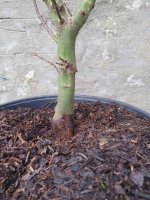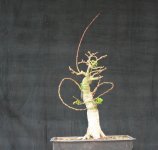Hi folks
I got this shishi today for £55/$70. I know there are some nuances with this variety to learn.
Either way I am excited to try and at the very least it will make a great garden tree.

The graft is not bad, haven't exposed it all yet but the root stock is the same thickness and goes down dead straight about 4 inches. Root structure unknown.

My plan is air/ground layering to start getting some extra trees to play around with.
My inexperienced eyes are telling me the trunk is boring no movement, taper and already some swelling.
Are there any branches that are screaming out as a starting point ?
(Will take a closer look later currently)
Thanks !
I got this shishi today for £55/$70. I know there are some nuances with this variety to learn.
Either way I am excited to try and at the very least it will make a great garden tree.

The graft is not bad, haven't exposed it all yet but the root stock is the same thickness and goes down dead straight about 4 inches. Root structure unknown.

My plan is air/ground layering to start getting some extra trees to play around with.
My inexperienced eyes are telling me the trunk is boring no movement, taper and already some swelling.
Are there any branches that are screaming out as a starting point ?
(Will take a closer look later currently)
Thanks !



